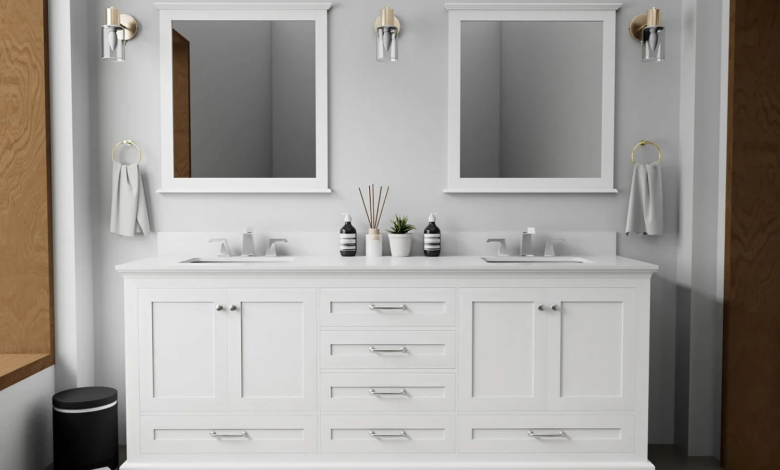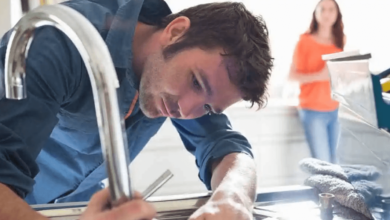Plywood Bathroom Vanities: Advantages, Drawbacks, and Practical Advice

When it comes to bathroom vanity materials, plywood is often considered a “niche choice.” Unlike solid wood, it doesn’t naturally exude texture, and unlike engineered stone, it isn’t highly water- and stain-resistant. Yet, due to its affordability and ease of customization, it has become a consideration for DIY enthusiasts or those on a tight budget.
But bathrooms are inherently humid and wet, demanding high material stability. Can plywood truly stand up to such an environment? This article explores the feasibility of using plywood for bathroom vanities from three angles: characteristics, suitable scenarios, and handling techniques.
Understanding Plywood: Core Characteristics and Bathroom Compatibility
Plywood is made by stacking multiple thin wood veneers (plies) with alternating grain directions and bonding them under pressure with glue. Its features have both alignment and conflict points with bathroom requirements, so understanding its essence is crucial before deciding on suitability.
Compared to solid wood or engineered stone, plywood offers several advantages in specific scenarios, especially for those seeking cost-effectiveness and flexibility:
High cost-performance, controllable budget:
For the same size and thickness, plywood costs only 50–70% of solid wood (e.g., oak or ash) and is cheaper than engineered stone or sintered stone. For example, high-quality 18mm plywood is around ¥150–200/m², while solid wood boards are ¥300–500/m². For budget-conscious users seeking a “wood-like” finish, plywood is an economical choice.
Structurally stable, resistant to warping:
Its cross-laminated structure balances internal wood stresses, making it far less prone to shrinking or cracking compared to solid wood. This is a key advantage in humid bathrooms, especially during rainy seasons or in poorly ventilated spaces, reducing the risk of warped cabinets or deformed countertops.
Easy to process, highly customizable:
Plywood’s uniform texture makes cutting, drilling, sanding, and shaping easier. Curved countertops, custom-sized cabinets, or DIY finishes (painting, veneer) are all feasible. For instance, users favoring a vintage look can paint the plywood dark brown and pair it with brass fittings to create a low-cost retro vanity.
4 Key Drawbacks: Natural Challenges in Bathrooms
Despite its advantages, bathrooms pose inherent challenges: high humidity, frequent water exposure, and standing water. If not addressed, these drawbacks can severely shorten plywood’s lifespan:
Poor water resistance, prone to swelling:
Glue layers and veneer joints are weak points. Moisture can seep through seams, causing layers to separate and boards to swell (moisture content over 15% can lead to 3–5% expansion), sometimes resulting in warped cabinets or misaligned doors.
Surface prone to staining, hard to clean:
Untreated plywood surfaces are porous and absorb water, oils, and cosmetic residues (foundation, lipstick). Over time, this leads to yellowing or mold, especially on countertops exposed to daily use.
Limited load-bearing capacity:
Common 18mm plywood can handle roughly 30kg/m² under even load. Heavy items (large mirrors, multi-tier shelves) or wall-mounted cabinets require reinforcement; otherwise, bending or cracking may occur.
Environmental concerns due to glue:
Plywood’s eco-friendliness depends on the glue used. Standard urea-formaldehyde glues can release formaldehyde, especially in humid environments. Low-formaldehyde alternatives (like MDI glue) are safer but more expensive, reducing cost advantages.
Essential Treatments: 3 Steps to Improve Plywood Vanity Durability
If you choose plywood, targeted treatment is key to adapting it to bathroom conditions. Focus on waterproofing, reinforcement, and surface protection:
Step 1: Waterproofing — Blocking Moisture from the Inside Out
Pre-treatment of boards:
- Choose waterproof plywood: Look for “waterproof grade” (e.g., IPX4+) or marine plywood, which has superior glue and veneer treatments.
- Apply waterproof coatings: Before cutting, coat all board surfaces, edges, and joints 2–3 times with wood sealant or polyurethane, letting 24 hours dry between coats.
Post-installation protection:
- Double waterproofing for countertops: Apply a waterproof layer (e.g., ≥0.5mm epoxy) or cover with waterproof materials (PVC, fireproof board), adding a 5mm+ water stop at edges.
- Cabinet base and wall joints: Use rubber or foam pads under cabinets, and seal joints with mold-resistant silicone. Inspect every six months.
Step 2: Structural Reinforcement — Ensure Stability
Countertop reinforcement:
Add 1–2 layers of plywood underneath as backing, fastened with screws to create a double-layer structure. Avoid excessive overhangs (>15cm) without support.
Cabinet reinforcement:
Floor-standing: Install L-shaped metal brackets in internal corners to maintain stability.
Wall-mounted: Embed load-bearing supports in walls, fixing cabinets with expansion bolts (≥4 per m²), ensuring ≥80kg capacity.
Step 3: Surface Protection — Improve Cleanability
Countertop surfaces
Cover with fireproof board, PVC film, or thin sintered stone (3–5mm), sealing edges. For wood aesthetics, apply 2–3 layers of wear-resistant varnish.
Cabinet surfaces
Paint with matte waterproof paint or apply veneer and varnish. Line drawer bottoms and door interiors with waterproof paper or PVC to protect stored items.
Suitable Scenarios for Plywood Vanities
With proper treatment, plywood can be practical in these situations:
Budget constraints, low-cost transitional solution:
For budgets ≤¥2000 or temporary rentals, plywood offers an economical choice. Example: an 80cm floor-standing plywood vanity with fireproof countertop and white waterproof paint can cost <¥1500—50% cheaper than wood or engineered stone.
DIY enthusiasts, custom shapes needed:
Curved or irregularly sized cabinets are easy to achieve with plywood. Small apartments with angled walls can use triangular plywood vanities efficiently.
Style fit: industrial or minimalist:
Exposed plywood grain complements industrial or Japanese minimal aesthetics without complex decoration. Example: an industrial bathroom with cement tiles, black metal frame, and wall-mounted plywood vanity with gray waterproof paint.
Scenarios to Avoid
Avoid plywood in these cases:
- Poorly ventilated, persistently humid bathrooms
- Long-term use (≥10 years) requiring high durability
- Households with children or elderly where safety and cleanability matter
- High environmental standards or formaldehyde sensitivity
In these cases, choose engineered stone, multi-layer solid wood, or sintered stone instead.
Comparing Materials: Plywood vs. Alternatives
| Material | Waterproof | Durability | Cost-effectiveness | Eco-friendly | Suitable Scenarios |
| Plywood (treated) | Medium | 5–8 yrs | High | Medium (choose low-formaldehyde) | Budget DIY, temporary use |
| Multi-layer solid wood | Good | 8–12 yrs | Medium | Good | Long-term, natural wood finish |
| Engineered stone (acrylic) | Excellent | 15–20 yrs | Medium | Excellent | Easy-clean, durable |
| Sintered stone | Excellent | 20+ yrs | Low | Excellent | High-end, extreme durability |
| Integrated ceramic basin | Excellent | 15–20 yrs | Medium | Excellent | Minimalist, waterproof |
If you like plywood’s flexibility but worry about waterproofing and durability, consider multi-layer solid wood or a hybrid (plywood cabinet + engineered stone countertop) to balance cost and practicality.
Conclusion
Plywood is neither “perfect” nor “terrible” for bathroom vanities. Its value depends on usage scenario and treatment methods.
- In budget-conscious, DIY-friendly contexts with proper waterproofing and reinforcement, plywood is practical and economical.
- In high-humidity, long-term, or high eco-standard situations, its drawbacks can outweigh advantages, making alternative materials safer.
Choosing materials isn’t about following trends; it’s about balancing your needs and environment. With proper care, Giving Tree Home plywood bathroom vanity can add unique style and functionality to your bathroom. For worry-free durability, engineered stone or multi-layer solid wood remains the safer choice.




